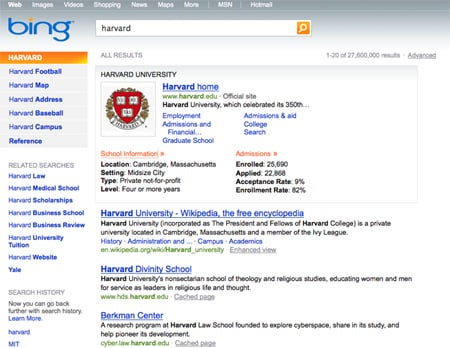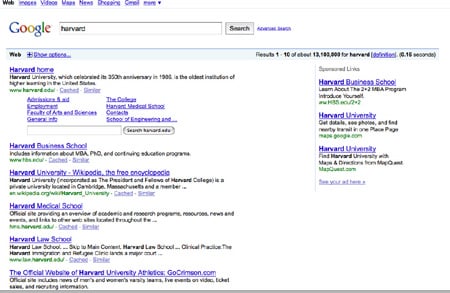Original URL: https://www.theregister.com/2009/12/03/bing_updates/
Microsoft promises 'open' Bing strategy
Silverlight sneaks in
Posted in Legal, 3rd December 2009 05:20 GMT
Microsoft is committed to an open online strategy to include partners and developers and build market share, while unveiling updates to Bing with a decidedly Microsoft flavor.
Satya Nadella, senior vice president of Microsoft's online services division, said Wednesday that the company's goal is for a "third-party scale model." That means bringing in content providers and application developers.
It wouldn't be practical given Bing's current 9.9 per-cent US market share and third-position behind Google and Yahoo!, to push a Microsoft-online stack.
Nadella was speaking after Microsoft had unveiled new features in Bing search that draw on Microsoft's reading of algorithms and traffic and rely on its data-center computing and storage architecture. Also unveiled was a Bing Maps beta using its Silverlight media player and some labs technology to knit photos and maps together to provide an hyper 3D feel to city maps.
"Are we trying somehow to reinforce just a Microsoft stack and tools message? That's not our intent," Nadella told press Wednesday in San Francisco, California.
"We do want to be able to get to an open strategy that allows us to tap into the ecosystem and give the ecosystem and economic return added value for doing so," he said.

Bing does Harvard: Entity Cards and Task Pages pull back structured data
At the event, Microsoft unveiled Entity Cards and Task Pages for Bing search. These will be injected into searches and provide not just relevant information and reduce searches but to also make sure there's a reasonably high-degree of consistency in the way information is returned each time across Bing.
Entity Cards and Task Pages are designed to reduce the number of follow-on searches you make on a subject, by sucking in related structured data from third parties that's considered relevant to a query.
Microsoft demonstrated a search for "Harvard University." At the top of the Bing page, you got the university's web site along with data considered relevant about the university and admissions process that can be clicked on. One click served up the number of men and women admitted, for example. Also demonstrated was a search for "Cold Play" that returned the band's official home page, selected images, and links to relative information such on gigs and links through to buying tickets.

Google flunks it: more digging is needed to get the goods
A compare and contrast with a search on Google for Harvard revealed Bing packs more information in to a tight and clickable space than the same Google search. With Google, you'd need to do subsequent searches and scroll down as you want more information.
Microsoft has "a lot of cards" for all major universities, stores, and brands - including Apple - and there are cards for flu and related drugs.
The Bing Maps beta features Streetside - Microsoft's version of Google's Street View - and an enhanced version of Bing's existing aerial view of US cities. Microsoft's fleet of black cars have, apparently, been criss-crossing 100 major US cities photographing them in minute detail.
Streetside and aerial view combine Bing's existing 3D maps in Virtual Earth with Silverlight and Microsoft's Live Labs' Photosynth for Deep Zoom, stitching together aerial and street photos together, providing seamless transitions as you move along a street or fly above a city, and letting you transition from a map to a photo view in one game-like 3D view.
Looking ahead, Microsoft demonstrated the ability to combine photo synths - pictures taken by users and posted to maps - search using maps and to combine Twitter images, feeds, updates, and profiles with search results. Integration with Facebook is also planned.
The catch
The only catch with the Silverlight diet is that this is a Microsoft-only technology. Also, you'll need Microsoft's Visual Studio or Expression to do most of your coding and debugging or design. While there is an Eclipse-based Silverlight project, Eclipse4SL, the question is how deep integration goes with Visual Studio and Expression design suite.
Microsoft played up the fact that Silverlight isn't restricted to just running in Internet Explorer and that it's built on and consumes REST, ATOM and SOAP, and VC1 and H.264 for media content. But that comes in addition to some very Microsoft-specific technologies, such as LINQ and Windows Presentation Foundation that do tie Siverlight into Windows and .NET.
Microsoft defended its use of Silverlight, saying it would be impossible to get the same level of "richness" with AJAX - Google's preferred option and also that of the Web 2.0 in crowd. It picked Silverlight in the spirit of empowerment, not in the spirit of trying to lock a stack in, one of the team leading the spatial mapping work told The Reg.
On Entity Cards and Task Pages, meanwhile, Microsoft is building these itself for now but Nadella made it sound like it's open to third parties helping. Currently, third parties are simply providing the data the cards and pages pull in. Nadella said Microsoft's goal is to take what it called "proprietary" content and information that's indexable or crawlable and use it in a query stream.
How Microsoft opens up the building of cards and pages to outsiders is difficult to tell. Until then, it sounds like Microsoft will rely on deals with content partners to open up their repositories and supply the information needed to make the whole idea work.
Nadella noted, however, that the goal is not to simply get content deemed "non Google" to achieve differentiation. He also wouldn't comment on reports Microsoft might pay for News International content the news giant's ripped from Google.
Aggregation master
Ultimately, the cards and pages see Bing playing the role of content aggregator. Microsoft is filtering its own search results, looking for commonly searched topics and clusters of searches to group together information considered relevant. Natella told The Reg: "There are garaged information sources, the problem in the past is how do you go from query to aggregated source.
"If you have enough annotations around a query in terms of your understanding you can do a better job of ranking even structured information. We've redefined our ranking problem to include a lot of structured information and optimized that - we will keep at it."
According to Nadella, Microsoft's growing Bing annotations infrastructure is designed to automate the presentation of structured results. "We've built an infrastructure for curating large amounts of structured data - we have significant systems investment as opposed to human creation," he told press earlier.
"That said there needs to be a continuous set of technology advances so bad data doesn't come across so freshness isn't an issue...this notion of structured data is an entirely new area were we are making investments in automating it." ®